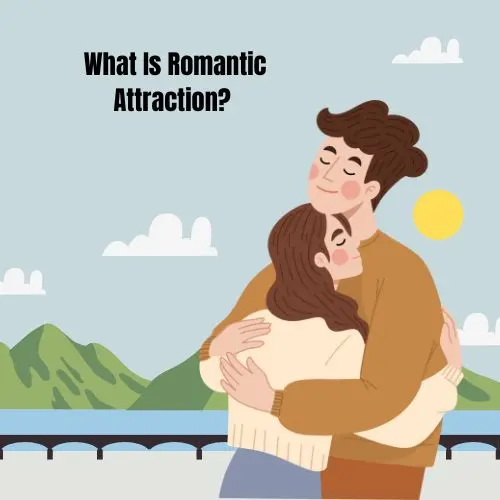Have you ever felt a magnetic pull towards someone that left you confused, excited, yet anxious all at once? Romantic attraction is a complex phenomenon that plays a big role in our relationships and personal development. Let’s dive deeper into understanding this intriguing aspect of human psychology and behavior.
A Quick Glance at Romantic Attraction Facts:
| Type of Attraction | Description |
|---|---|
| Physical Attraction | Drawn to someone based on their looks, physique, style, or first impressions. |
| Emotional Attraction | Connected to someone on a deeper emotional level due to shared interests, values, or compatible personalities. |
| Sexual Attraction | Feel a desire to be physically or sexually intimate with someone. |
What is Romantic Attraction Scientifically?

Scientists define romantic attraction as a sub-type of social attachment that motivates us to seek affectionate companionship from a preferred other. It involves perceptions and emotions oriented around physical proximity, emotional synchrony, and caregiving behavior with that special person.
On a physiological level, romantic attraction lights up brain reward centers, releasing feel-good neurotransmitters like dopamine, serotonin, and oxytocin, released when we experience intimacy or acts of love/care from our beloved. This helps reinforce romantic bonding behavior critical for reproductive success and nurturing offspring in humans and other socially monogamous species.
While the precise neurobiological mechanisms are still being decoded, research suggests genetics, personality traits, relationship histories, socio-cultural conditioning, and situational contexts interact to influence romantic attraction formation and its intensity in each individual. No two people experience it identically due to these complex combinations.
Types of Romantic Attraction

Different aspects contribute to the complex experience of being romantically drawn towards someone:
- Physical Attraction: Appreciating someone’s appearance, physique traits, and intimacy charm is usually an early driver of catching our fancy. However, looks alone rarely sustain attraction in the long term.
- Emotional Attraction: Connecting with someone on an intellectual/emotional wavelength through shared values, goals, hobbies, and compatible personalities strengthens bonds beyond superficial levels.
- Sexual Attraction: Distinct from physical attraction, this refers to the intrinsic desire and chemistry to be sexually/physically intimate with a partner. It’s a crucial component of most romantic relationships.
- Spiritual Attraction: Some experience profound resonance with a partner’s essence, character, or zest for life on a deeper soulful plane beyond earthly fixations, which elevates relationships.
- Situational Attraction: Circumstances like proximity, availability, and life stage compatibility also influence our propensity to be attracted initially, though they may not guarantee lasting attraction.
Many also experience ambivalent romantic feelings that combine positive and negative emotions towards a potential partner, such as excitement mixed with anxiety or nervousness in the initial stages. Overall, attraction results from a dynamic interplay between these multifaceted layers in unique variations for every person.
Stages of Romantic Attraction Development
Common stages witnessed as romantic attraction strengthens into a committed bond are:
- Initial Infatuation: Characterized by an intense rush of feelings like lust, excitement, and idealization at someone’s first impressions. Physical attraction and fleeting interactions often trigger infatuations.
- Exploring Compatibility: Emotional and intellectual compatibility takes center stage as people date and open up more. Compatible personalities, tastes, and shared interests help maintain attraction.
- Attachment Bond Forming: Strong attractions transition into deeper feelings of trust, comfort, and caregiving through consistent quality time spent together building intimacy.
- Long-Term Partnership: Mature, secure relationships witness fluctuations in initial infatuation levels but maintain steady attraction based on profound acceptance and understanding of each other, with flaws included.
- Long-Term Commitment: Lasting marriages see attraction basis shift towards companionship, intimacy routine, and family priorities rather than fleeting passions alone. Appreciation and efforts sustain closeness.
Of course, romantic attraction may fizzle out or reduce at any stage if intimates prove incompatible or neglect the relationship. Communication remains key to consciously navigating changing attraction levels over the years together.
Individual Differences in Romantic Attraction

As with any psychological experience, people differ widely in their romantic attraction patterns due to genetics and personality traits. Some of the most impactful variations include:
- Attachment Style: How we learn to bond from childhood impacts adult attraction. Those with insecure attachments may struggle to form or maintain healthy attractions.
- Sensation Seeking: Highly sensation-seeking types crave novelty more, so attractions may come and go quickly. Low sensation-seeking partners prefer stability.
- Emotional Regulation: Being easily overwhelmed by intense emotions or unable to process feelings healthily affects romantic interests.
- Self-esteem: Feeling unlovable or overly dependent impacts who we feel is worthy of attracting and keeping long-term.
- Gender: Generally, men prioritize physical attractiveness more in initial encounters, while women value resources and stability indicators. However, individual preferences vary.
- Cultural & Familial Values: Societal mores and familial influences shape romantic standards and choices from a young age.
- Sexual Orientation: Attraction differs depending on whether oriented towards same or opposite-gender partners or both.
Accepting our natural patterns along with a partner’s is key to maintaining compatibility and managing expectations realistically in romantic involvements. Communication helps accommodate each other respectfully over time, too.
Growing Attraction Through Conscious Care
While early attractions happen instinctively, maintaining those feelings long-term requires effort and daily acts of care. Research reveals these continuously strengthen emotional and sexual bonds:
- Express Gratitude & Appreciation: Thanking a partner through words and actions daily makes them feel valued.
- Prioritize Quality Time Together: Bonding occurs through shared experiences beyond coexistence under one roof.
- Support Each Other’s Growth: Being interested in nurturing personal development fosters long-term admiration.
- Engage In New Activities Together: Sparking novelty helps prevent relationship ruts from draining passion.
- Communicate Openly Yet Sensitively: Address issues through understanding, not accusations, to avoid building resentment.
- Express Affection Through Touch Regularly: Holding hands, hugs, and other displays of physical affection release feel-good hormones and reinforce pair bonding.
- Celebrate Small Wins & Successes: Cheerleading each other through highs and lows strengthens the team dynamic.
- Compromise & Resolve Conflicts Respectfully: Finding balanced solutions through cooperation preserves mutual respect.
- Practice Acts of Service: Going out of your way with favors builds goodwill banked for long hauls together.
Consistent caring nurtures attraction and resilience to withstand life’s ups and downs, maintaining that special spark alive for years. Neglect inevitably risks disconnect strengthening.
Strategies For Staying Romantically Attracted
Maximizing attraction potential requires insight into each other’s preferences and concerted efforts. Techniques like these go a long way:
- Foster Emotional & Physical Intimacy Routinely: Consistency and creativity are key for maintaining sexual chemistry and connectedness.
- Express Gratitude For Mental & Physical Attributes Mutually Valued: Daily reminders help preserve the initial appeal of one’s wholesomeness.
- Engage In Shared Activities & Pursuits You Both Enjoy: Compatible interests ignite passions, whereas incompatibilities drain them.
- Prioritize Quality Couple Time Daily Beyond Coexistence: Meaningful bonds thrive on interactions, not just parallel lives under one roof.
- Practice Acts of Service For Each Other Regularly: Little gestures communicate you care about their needs, not just your own.
- Communicate Openly Without Criticism: Address concerns respectfully to nurture understanding instead of separateness.
- Express Affection & Admiration Generously: Don’t assume a partner automatically feels your care; regularly make efforts to show it.
- Align On Relationship Values & Goals Jointly: Shared vision and cooperation withstand challenges better than disjointed agendas.
- Pursue Individual Growth Simultaneously: The healthiest relationships inspire each other’s personal fulfillment outside the pairing, too.
- Resolve Conflicts Constructively Through Compromise: Finding balanced solutions strengthens trust beyond avoiding all tensions.
- Cherish Small Wins & Successes Mutually: Appreciating each other’s contributions fosters the team dynamic, which is crucial for long hauls.
Consistently practicing these research-backed strategies nourishes passion’s longevity, surmounting inevitable bumps together over the years. Prioritizing daily efforts honors the significance of the initial magnetic pull between intimates today.
Conclusion
Romantic attraction’s complex allures empower our deepest connections while demanding conscious diligence and cultivating reciprocated care, fun, understanding, and trust, binding committed couples. Does this help explain love’s captivating yet evolving nature, subtle yet profoundly impacting human happiness?

